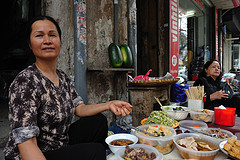Tips for a Safe Street Food Experience
8 March 2014

Street food vendors provide ready-to-eat food and beverages that are prepared and/or sold by vendors on the street, i.e., not inside cafes or restaurants. In some parts of the world, street vendors have noticeably increased due to a rough economy, rampant unemployment, and the rapidly growing demand of urban dwellers who need cheaper food products in the face of a difficult economy.
In particular, street food has become an important part of food distribution in developing and industrialized countries, particularly for midday meals.
In addition, street food vending has become an important employment opportunity for millions of people who may have limited access to education and/or funding especially because the initial investment is relatively low.
In some areas of the world, street food has attained a kind of cult following with fans following the Twitter feeds of their favorite vendors so they can buy their next meal. Street food often reflects traditional local cultures and vendors offer an endless variety of encompassing meals, drinks, and snacks that are appealing to many travelers – especially those on a budget or short on time.
Street Food Vendors are Diverse and Ingenious
Types of street vendors can range from stationary street stalls to a wide variety of push-carts, bicycles, and vans depending on the individual vendor’s ingenuity, the resources available, the type of food sold, and the nearby facilities. The type of food also displays a wide variety of ingredients, processing, and methods of both marketing and consumption.
Street vendors also prepare their foods in a variety of places, including:
- Small-scale workshops
- At home
- In markets
- On the street itself
The food is packaged into the cart or stall and maybe kept heated. The diversity of situations in which street food is prepared and handled presents certain potential risks, but safe food can be prepared on the street if proper food handling measures are observed. For example, food that is cooked to 70 degrees Celsius and consumed piping hot poses little to no risk of pathogenic microorganisms, regardless of the sanitary conditions of the environment.
Reported Risks of Street Food
While street food has become an important source of ready, low-cost food for the urban poor but the health risks posed by such foods may outweigh their benefits. Street food has often been associated with travelers’ diarrhea, thus improvements in the safety of street food are an important public health concern as well as tourist concern.
The potential risks of street food, according to a World Health Organization (WHO) International Food Safety report June 2010, include the following:
- High levels of toxic chemicals, pesticide residue, heavy metals and unapproved food additives such as textile dyes
- Pathogenic bacteria such as Salmonella, Staphylococcus aureas, Clostridium perfringens, and Vibrio cholera
- Contaminants may also be introduced where dust and vehicular traffic contribute to pollution levels
In many countries, the laws governing food safety and environmental hygiene have been enacted. For example, the Thailand Department of Health developed a ten-point code of food safety practices for vendors.
In another study Keeping up Appearances: Perceptions of Street Food Safety in Urban Kumasi, Ghana (September 2008), it was noticed that consumers prioritize price and accessibility of food – failing to put much thought into food safety. They rely on simple risk avoidance strategies assessing the neatness and appearance of the street vendor’s operation without regard to whether food safety practices are being followed.
In some countries, there are no specific regulations on street food safety, and even where regulations exist enforcement is a particularly difficult problem due to the sheer number of street food vendors and the fact that their mobility makes them difficult to track.
8 Tips for a Safe Street Food Experience
The street food of many countries is regularly described by travelers as some of the best food they’ve ever had, but then reports of suspect food handling, scary ingredients, and trips to the hospital create a conflicting view.
- Give yourself a few days to adjust to the local cuisine before trying street food, especially if you are not used to spicy food.
- Follow the crowd. If the locals avoid a particular vendor, you should too. Any place that is crowded and popular with families is usually a safe bet.
- Take a little time to watch a street vendor, notice their habits of cleaning utensils, using tongs, and keeping the food covered, etc.
- Check the color of the oil being used to fry foods. If the oil is cloudy, or has bits of debris in it, those are telltale signs the oil is being re-used.
- Notice whether the pots and surfaces are dirty, whether there are scraps of food sticking to the cart surface or utensils, for example.
- Avoid anything stored in a jug (like fruit juice) unless you are convinced of the vendor’s washing practices.
- If the country you are visiting has franchised food carts, those are more likely to be staffed by vendors trained in basic food safety.
- Avoid any food that is not thoroughly cooked because it could contain various parasite strains that are known to wreak havoc with the human digestion system.
Note: don’t beat an immediate and hasty retreat if you order something that is deep-fried and sees the cook throw it back in the wok. It’s common practice to partly cook some foods and finish them off once they are ordered. In fact, as long as the cooking oil is clean, the practice of frying them hot again will eliminate the germs.
Damian Tysdal is the founder of CoverTrip, and is a licensed agent for travel insurance (MA 1883287). He believes travel insurance should be easier to understand, and started the first travel insurance blog in 2006.
